ABSTRACT
This study examined the Evaluating the Impact of Social Pressure on Academic Performance of HUMSS 11 Students, from students at Nasugbu East Senior High School. Descriptive studies were used in the study to explain the overall conclusions. The sample population for this study consists of One Hundred Eighty-Three (183) G11 HUMSS students. Most participants will probably enroll in the HUMSS Strand of Senior High School. The conclusion implies the most significant Impact of Social Pressure on Academic Performance of HUMSS 11 Students influence the people to experience the pressures on their achievements and academic performance.
Most participants answered that the different social pressure experienced by the HUMSS 11 students are the having a social anxiety disorder or an intense persistent fear of being watched and judged by other strand, overwhelm by expectation, and peel pressure to get higher grade and The specific sources of social pressure had the most significant impact on human students’ academic performance are having intense desire to be accepted and belong to a social group, social pressure is a major factor in HUMSS Students academic performance and being afraid of sacrificing their personal passion for academic success.
Moreover, the researchers recommended that schools should establish regular dialogues between students, educators, and parents to address concerns and promote a balanced approach to academic success. Moreover, schools should help to teach students techniques like deep breathing, meditation, or yoga to calm their minds and reduce stress. And also, students should maintain adequate sleep, Sleep is crucial for cognitive function, memory consolidation, and emotional regulation.
CHAPTER 1
THE PROBLEM AND ITS BACKGROUND
Introduction
The overwhelming effects of social pressures have no exception, especially to students. This may affect their academic performance and behavior as they encounter tasks as senior high school students. Social pressure is one of the several factors that may affect their overall educational experience as it can be influential to their academic performance.
According to Flores et. at (2022), social pressure can have the students support and confidence. Flores identify that it can lead to a lack of confidence and abilities and output on academic performance.
In addition, Ercigel (2023), students' mental health can be severely impacted by academic pressure, which is defined as high standards, fierce competition, and a never-ending quest for academic success. Parents, teachers, friends, and society expectations are just a few of the many sources of this pressure. These demands may cause students to feel stressed, anxious, depressed, or even burn out. It can cause a reduction in general wellbeing and show up as physical symptoms like headaches and sleep difficulties.
Researchers at Nasugbu East Senior High School seek to assess the impact of social pressures on Grade 11 students' academic performance in the humanities and social sciences. They also hope to collect data on these effects to design and develop educational programs regarding social pressure that will provide insightful information on the subject.
Background of the Study
Research has shown that peer pressure has a substantial effect on academic success. Adeyemi (2019), Negative peer impact can impair academic achievement the positive peer pressure can boost it. Research has found that when low-performing pupils contact high-performing peers, their academic performance increases dramatically.
In addition, According to Ziye Ma (2023), the academic pressure of students is a hot issue concerned by the school, family and all walks of life. Academic pressure will have a lot of impact on students' psychology, physiology and so on, and also affect their academic performance.
With the gathered data, the researchers utilize the descriptive research design to evaluate the Impact of social pressure and academic performance of HUMSS 11 students at Nasugbu East Senior High school. The findings were the basis of proposed educational program for students that will contribute to a different standing of this topic.
Statement of the Problem
The study aimed to evaluate the impact of social pressure on academic performance of HUMSS 11 Students at Nasugbu East Senior High School, Barangay. Lumbangan Nasugbu, Batangas, Academic year 2024 - 2025.
Specifically, the study sought answers to the following questions:
1.What are the different social pressures experienced by the HUMSS students?
2. What specific sources of social pressure have the most significant impact on HUMSS students' academic performance?
3. What program should be developed regarding the impact of social pressure on student academic performance?
Scope and Limitations of the Study
The study is focused on evaluating the Impact of social pressure on academic performance of HUMSS 11 Students at Nasugbu East Senior High School, Barangay Lumbangan, Nasugbu, Batangas.
The study was limited only to Humanities and Social Sciences Students from the Nasugbu East Senior High School. The data was solely gathered from the respondents’ answers in the survey questionnaire. The findings were the basis for the proposed education program for students that should be develop the understanding impact of social pressure on students’ academic performance.
Definition of Terms
These are the conceptual and operational definitions of the following words and phrases used in this study for clearer understanding of the research:
Peer influence - we define the construction of peer influence and discuss its manifestation in friendships and peer groups. Although our focus is on adolescence, the definitions we advance are appropriate for all age periods (Adolesc, 2021). In this study, Influence assumes directional change. The direction of change is determined by the characteristics of the partner or group, with heightened similarity as the end point.
Distraction- is something that distracts: an object that directs one's attention away from something else. (Axelrod, 2024). In this study, distraction is also a problem in terms of academic performance of a student. Distractions can take many forms, including our phones, computers, friends, or our own thoughts. In college, distractions can be even more abundant than in high school, because there are so many new opportunities and experiences available.
Insightful - Insightful is an employee monitoring software that focuses more on overall productivity trends across organizations, projects or teams rather than monitoring individual employees (Rudder, 2024). In this study, insights had significance to our research because we need the perceptions or insight of our respondents.
Fear - Fear is one of the seven universal emotions experienced by everyone around the world. Fear arises with the threat of harm, either physical, emotional, or psychological, real or imagined (Wong, 2023). In this study, the fear of learning can be challenging for students in academic performance, this study relates into social pressure on academic performance of an individual student's.
Social pressure- Social pressure is the influence that people feel from others in their social circle or society at large to act, think, or behave in a certain way. It can encourage positive actions, like being kind or working hard, but it can also push individuals towards negative behaviors, such as conforming to harmful norms or engaging in risky activities just to fit in. (Ciletti, 2024). In this study, social pressure can influence in many aspects it also can affect the behavior of the students and individuals. There are so many social pressures that also can affect our mental stability, the common experienced of social pressure is students, because of that he/she is engaging risky activity cause by depression and social pressure.
Significance - Most English students are familiar with Roget’s Thesaurus, but its significance extends beyond mere synonyms and antonyms: users can navigate through a rich array of words to find the most precise way to express their ideas. (Forbes, 2024). In this study, we talk about ng significance impact of social pressure, significance determines the importance of research and the different aspects of valuation.
Adolescent - Adolescence is the exciting yet stressful time when your child transitions into adulthood. Many rapid changes and developments take place during this time, and it’s not always a smooth ride. Through the physical, cognitive and psychological changes, your child will begin to discover who they are and where they belong (Cleveland Clinic, 2024). In this study, adolescents are a stage where young people experience it. It is based on the behavior of the students; adolescents also can affect the academic performance of some students.
Stress - Stress is how we react when we feel under pressure or threatened. It usually happens when we are in a situation where we don't feel we can manage or control (Fundraising Regulator, 2022). In this study, stress defines stress as the one of the most experienced by the respondents , because social pressure on academic performance is the cause of stress due to work overload and other people's judgments.
Respondents - In the context of research, a respondent refers to the individual who participates in research by completing surveys, questionnaires, interviews, or other data collection tools (Ben Jansen, 2024). In this study, respondents represent the HUMSS 11 students who encountered social pressure on academic performance.
Data Collection - The process of gathering and analyzing accurate data from various sources to find answers to research problems, trends and probabilities, etc., to evaluate possible outcomes is Known as Data Collection (Simplilearn, 2024). In this study, data collection is the process of collecting and evaluating information or data from multiple sources to find answers to research problems, answer questions, evaluate outcomes, and forecast trends and probabilities.
CHAPTER 2
REVIEW RELATED LITERATURE
Different social pressure experienced by the HUMSS Students
According to Haider (2022), social pressure that the students experience is family pressure, which also influences the students‟ academic performance. Family pressure, or the expectations and influences that a family places on an individual, can have a significant influence on academic performance. In a study of Pakistani high school students, researchers found that students who experienced high levels of family pressure were more likely to experience academic stress, leading to lower academic performance.
Moreover, Filade et al., (2019) said that students may feel pressure to conform to certain academic or social standards or to meet the expectations of their peers, teachers, or families. These pressures can lead to stress, anxiety, and even depression, which can in turn affect a student's ability to focus, learn, and perform at their best.
Peer pressure is a form of social pressure that students may encounter that can affect them academic performance. Orillana (2018) defines peer pressure as the pressure from one's peers to conform to certain behaviors, values, or norms to be accepted. In an educational setting, students may feel pressure to be part of a group or have friends, which can be beneficial for their socialization and confidence.
Additionally, Parents set their expectations for their children as they know what could be good for them and for their children to be motivated in striving for the better. But some parents are only bringing pressure instead of making them strive to become and achieve better academic performance. Expecting their children to be always as good as others, or even better than others, only puts them into a difficult situation. Due to wanting to be better by learning more at school, they also develop levels of stress, pressure, and even anxiety that will only affect their performance at school. Being under pressure and stress does not guarantee that a student will achieve better academic performance as it only distracts the mind, resulting in performing poorly at school (Deb et al, 2015).
(Kulakow et al., 2021) Stated that, one of the major stressors of adolescence relates to the pressure that comes from their parents accompanied by high academic expectations. Parents nowadays are too concerned about the world perceive their students, which in turn results in parental pressure. Several large-scale international surveys demonstrate that general stress among youth is increasing, endangering students' psychosocial and academic development.
The specific sources of social pressure had the most significant impact on HUMSS students' academic performance
The influence of peers on an individual's behavior or decisions can have both positive and negative effects on students' academic performance. Some studies have found that peer pressure can lead to academic underachievement and negative behaviors such as substance abuse. Many students are under the influence and pressure of those around them (Leka, 2015).
According to Moldes (2019), students are expected to face the effects of peer pressure with optimism in order to cope with the negative influence of peer pressure on their studies. Students can take either a positive or negative approach to peer pressure.
Additionally, the teacher can guide and assist them in dealing with such problems. Contrary to the study of Wentzel (2016), children who have positive peer relationships have higher levels of emotional well-being, self-belief, and values for prosocial forms of behavior and social interaction than those who do not have positive peer relationships.
Furthermore, they are more motivated, engaged, and even excel at academic tasks than those who have peer relationship issues. Learning does not occur in an isolated setting, but rather through healthy engagement with various circumstances, one of which is peer group. As a result, it is possible to conclude that the peer group with whom a kid interacts will have a favorable influence on learning and academic accomplishment. This study investigated the influence of peers on pupils’ academic progress (Reang & Kaipeng 2022).
Contradict to the previous study, Mundhe (2018) found that there is a substantial association between parental income and academic success in students. The study also found a significant relationship between parents' educational level and students' academic success. As a result, it is proposed that faculties devote greater attention to the teaching and learning processes of students from low- income and educational backgrounds. In some cases, family pressure may be a source of motivation and support for students.
Theoretical Framework
This study was anchored on the theory of Afolabi A. (2019) as cited by SEAHI PUBLICATIONS (2019). Parents should have effective supervision on their children and should not allow any bad friends to distract their children in school. There is a need for teachers, lecturers and the institution authority to have greater supervision, rules and regulations to guide against bad gangs in the school environment. However, Government can also help by including subjects and courses that can curb bad behaviors in secondary schools and higher institutions to enlighten students more and let them know the consequences of a bad peer group.
The theoretical perspective is applicable in the present study as it compromises of various aspect and compassing components in social pressures on academic performance the interconnectedness of this concept linked in the social pressure on academic performance of HUMSS 11 students at Nasugbu East Senior High School relative to social pressures, students’ behavior, student's academic performance.
Moreover, acknowledging the importance of this theory would strengthen the crafting of learning materials to develop regarding the impact of social pressure on student academic performance as it will provide substantial parameters for inputs in its realization.
Conceptual Framework
Based on explained conceptual theory used in the study, the researchers found out that in order to make deaf knowledge and careful judgment about the relationship of the variables it required critical analysis of the variables to improve and to develop their feelings to avoid social pressure on their academic performance.
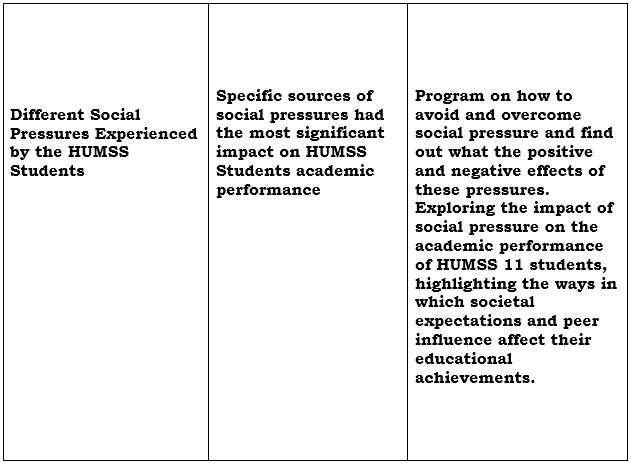
Figure 1 Research Simulacrum
Figure (1) depicts the study's research simulacrum. It demonstrates the relationship between social pressures and academic success, which influences student performance. Thus, the impact of the factors is determined. This study examines the impact of social pressures on academic performance of HUMSS students in Nasugbu East Senior High School. While the Humanities and Social Science strand is considered the most fundamental academic strand, we chose this topic to demonstrate the difficulty of navigating social pressures and express our emotions.
CHAPTER 3
RESEARCH METHODS AND PROCEDURES
This chapter presents the methods of research used. It also includes research design, scale and respondents of the study research instrument, construction and validation of instrument, ethical considerations, data gathering procedures and statistical treatment of data.
Research Design
The study used the descriptive research design to determine the Impact of social pressures on academic performance of Grade 11 students of Nasugbu East Senior High School. Based on scribbr 2019), descriptive research design aims to accurately and systematically describe a population, situation or phenomenon Descriptive research design can use a wide variety of research methods to investigate one or more variables. In this study, was Utilized by obtaining information or data of Evaluating the impact of social press on academic performance of Grade 11 students, by evidence-based analysis, problem solving. communication with the result and feedback mechanism. The a fore mentioned variables were included in the research as it was deemed significant to the present study.
Locale of the study
The study was conducted in Nasugbu East Senior High School located at Brgy. Lumbangan, Nasugbu, Batangas. It was founded in the year 2016. The school was headed by Principal Il, with fifty-one (51) teachers and four (4) non-teaching staff. It has a total population of one thousand three hundred three (1,384) enrolled students comprising grades 11 and 12. There is a total of three hundred three (303) population of Grade 12 Humanities and Social Sciences Students this School Year 2024-2025. The school offers academics which include Accountancy, Business and Management (ABM) strand, Humanities and Social Science (HUMSS) strand, Science, Technology. Engineering and Mathematics (STEM) strand, and Technical, Vocational, and Livelihood Track (TVL).
Respondents of the Study
The researcher used Slovin's Formula in computing the sample size population. Slovin's formula is used to calculate the sample size necessary to achieve a certain confidence interval when sampling a population. Hence, the sample size recommended using this formula was one hundred eighty-three (183) respondents with confidence level of 95 percent and Precision Level or margin of error of 5 percent. The sampling was applicable in the present study to represent the target population. After thorough study of the problem, the respondents were chosen using Simple Random Sampling (SRS) which involves selecting individuals from the population in such a way that every individual has an equal chance of being chosen. This sampling method has an equal and likely possibility of getting selected in the sample. Since the selection of items completely depends on the possibility, therefore this method is called "Method of chance Selection'".
Research Instrument
The researcher reviewed various literature in speculative assertion to construct the instruments of the study. A survey questionnaire was developed from these literatures and was utilized to gather pertinent data for the present research. Part I Different Social pressures experienced by the HUMSS Students. Part Il The specific sources of social pressures had the most significant impact on HUMSS Students Academic performance. It was rated on a 4- point Likert scale as follows 4-Strongly Agree, 3-Agree, 2-Disagree, 1-Strongly Disagree.
Construction, and Validation of the Instrument
The research instrument was Constructed under the expert guidance of the thesis adviser. For the several items we asked our expert people who knew a lot about the question until they were just right. Then after the revised we sent our questions to other advisers for the advice and kept changing the real measure of what we wanted to know. This helped us to make sure our questions are out of education. They looked at each item to check if they were valid and our study would give us the right answer and good feedback. In addition, this process of construction and validation of the instruments is to ensure that the research instruments are both reliable and valid.
Ethical Considerations
Part of the ethical Consideration of this study was to secure the consent of the Respondents to voluntarily participate. Before the respondents participated in this study each participant was given a copy of the consents. The researcher made sure that the consent was carefully explained to each respondent. It was further emphasized to ui respondents that participation in the study was voluntary and that they have the option not to participate in the study. Ethical principles were considered to preserve the integrity and dignity of the respondents.
Data Gathering Procedure
The school principal of Nasugbu East Senior High School and public-school district supervisor granted permission for the researcher to conduct this study prior to the distribution of the questionnaires. The request letter (Appendix A) was forwarded to the Office of the School Principal. Following the approval, the researcher informed the respondents of the research's goal before the survey and allowed for questions to address any concerns. Then the researcher gave the survey questionnaires to the study's target respondents, giving them plenty of time to complete them. In addition, the research sought the assistance of respondents to be able to honestly assess their Speculative Assertions. The accomplished survey questionnaire was checked by the researcher for completion of the respondents before retrieval.
Statistical Treatment of Data
The following were the statistical tools used in the study:
Problem 1. What are the different social pressures experienced by the HUMSS Students? Frequency and percentage. These were used to indicate the percentage of observation for each profile's variables (age, sex, and socio-economic status) and also to express the relative frequency of survey responses and data.
Problem 2. What specific sources of social pressures have the most significant impact on HUMSS Students Academic Performance?
Problem 3. Challenges Encountered by the Respondents: To identify the challenges encountered by the respondents by a survey questionnaire both online and face to face surveys.
CHAPTER 4
Presentation, Analysis and Interpretation of Data
This part presents the data gathered, analyses and interpretation to answer the problem which this study aims to achieve.
1. The Different Social Pressures Experienced by the HUMSS 11 Students
Table 1 presents the Different Social Pressures Experienced by the HUMSS 11 Students. Based on the six (6) indicators which are presented to the respondents during the conduct of the survey, the highest Weighted Mean is the respondents’ answers regarding having social anxiety or an intense, persistent fear of being watched and judged by another strand with weighted mean of 3.64 (SD=5.85), qualitatively describes as Sometimes Experience. This means that they sometimes experienced the pressures because of other strands. However, understanding not only words but also emotions being depicted by the speaker has the lowest weighted mean of 3.04 (SD=5.62) which means students need to develop communication to avoid social pressures. This indicator is qualitatively described as Sometimes Experienced.
Overall results show that the respondents mark “Sometimes Experience” on their Social Pressures experienced by HUMSS 11 Students with Grand Weighted Mean of 3.22 (SD=5.60).
This result is related to the study conducted by Reang & Kaipeng (2022). They are more motivated, engaged, and even excel at academic tasks than those who have peer relationship issues. Learning does not occur in an isolated setting, but rather through healthy engagement with various circumstances, one of which is peer group. This explained that additional communication development should be utilized to develop their communication and comprehension.
Table 1: The Different Social Pressures Experienced by the HUMSS 11 Students
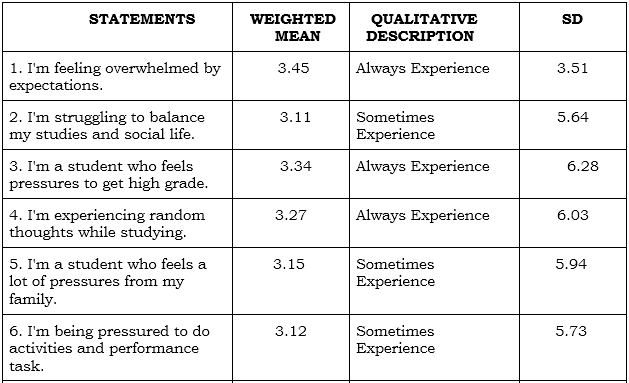
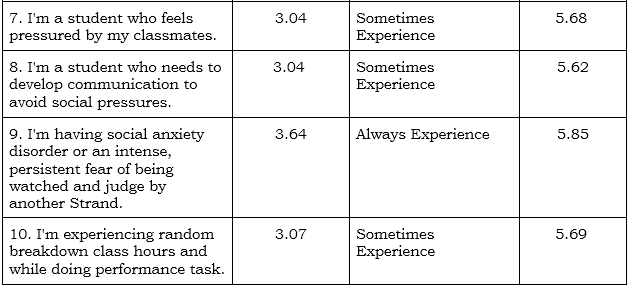
2. The specific sources of social pressure had the most significant impact of human students’ academic performance Table 2 presents the specific sources of social pressures that had the most significant impact of human students’ academic performance. Based on the six (7) indicators which are presented to the respondents during the conduct of the survey, the highest Weighted Mean is the respondents’ answers regarding intense desire to be accepted and belong to a social group with a weighted mean of 3.45 (SD=6.51), qualitatively describes as Always Experience. This means that they always experienced not being accepted and belonging to a social group. However, understanding not only words but also emotions being depicted by the speaker has the lowest weighted mean of 3.17 (SD=5.89) which means students question themselves and their own abilities. This indicator is qualitatively described as Sometimes Experienced.
Overall results show that the respondents mark “Sometimes Experience” on their specific sources of social pressure had the most significant impact of fume students’ academic performance with Grand Weighted Mean of 3.24 (SD=5.79).
This result is related to the study conducted by Orillana (2018) who revealed that peer pressure defines pressure as the pressure from one's peers to conform to certain behaviors, values, or norms in order to be accepted. This explained that they feel questioning their own abilities.
Table 2: The specific sources of social pressure had the most significant impact of HUMSS students’ academic performance
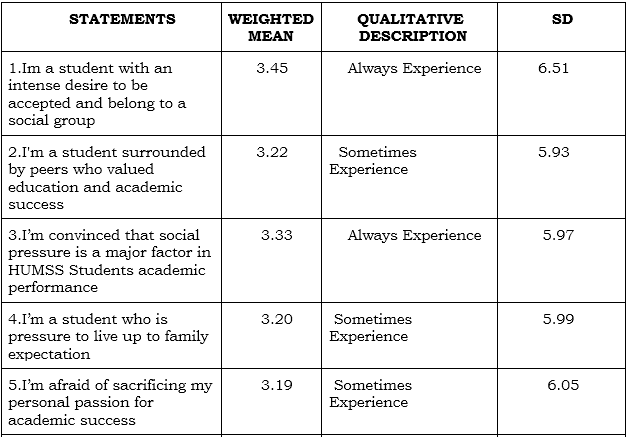
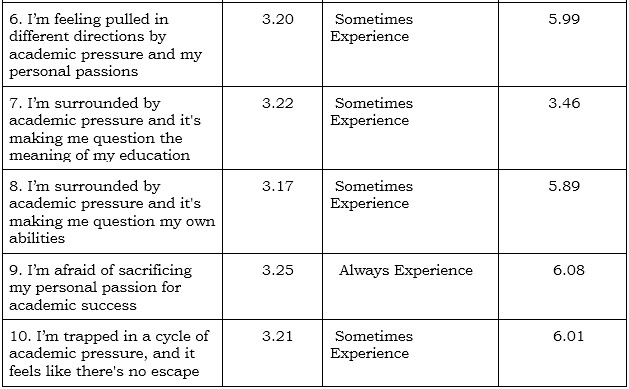
CHAPTER 5
Summary, Conclusion, and Recommendation
This chapter presents the summary of findings, conclusions, and recommendations of the study.
SUMMARY OF FINDINGS
1. The Different Social Pressures Experienced by the HUMSS 11 Students
The findings showed that respondents mark as results is Sometimes experienced on their social pressure experience by HUMSS 11 Students with grand weighted mean of 3.32 (SD=5.60).
2. The specific sources of social pressure had the most significant impact of HUMSS students’ academic performance
The findings showed that respondents mark as results is Sometimes experienced on their specific sources of social pressure had the most significant impact of HUMSS students’ academic performance with Grand Weighted Mean of 3.24 (SD=5.79).
CONCLUSIONS
Based on the findings of the study, the following conclusions are drawn:
1. Most participants answered that the different social pressure experienced by the HUMSS 11 students are the having a social anxiety disorder or an intense persistent fear of being watched and judged by other strand, overwhelm by expectation, and peel pressure to get higher grade
2. Most of the participants’ answers on the specific sources of social pressure had the most significant impact on human students’ academic performance are having intense desire to be accepted and belong to a social group, social pressure is a major factor in HUMSS Students academic performance and being afraid of sacrificing their personal passion for academic success.
RECOMMENDATIONS
Based on the proceeding findings and conclusions the following recommendations are offered by the researchers:
1. Open Communication Channels:
Teachers should establish regular dialogues between students, educators, and parents to address concerns and promote a balanced approach to academic success.
2. Promote Mindfulness and Relaxation:
Teachers should teach students techniques like deep breathing, meditation, or yoga to calm their minds and reduce stress.
3. Advocate for Adequate Sleep:
Students should maintain sleep is crucial for cognitive function, memory consolidation, and emotional regulation.
BIBLIOGRAPHY
Adolesc (2021) “Toward understanding the functions of peer influence” https://www.ncbi.nlm.nih.gov/pmc/articles/PMC8630732/
Axelrod (2024) “Distraction meaning “Merriam-Webster. (n.d.). Distraction. In Merriam-Webster.com dictionary. Retrieved November 21, 2024, from https://www.merriam-webster.com/dictionary/distraction
Adeyemi (2019) “Peer Pressure and Its Impact on Academic Achievements of Students on Secondary Schools. Journal of Positive School Psychology 2022https://www.journalppw.com/index.php/jpsp/article/view/5062
Ben Jansen (2024) “Respondents the definition” Janse, B. (2024). Respondents. Retrieved November 21, 2024 from Toolshero: https://www.toolshero.com/research/respondents/
Ciletti (2024) “Impacts Of Social Pressure” https://www.betterhelp.com/advice/general/how-does-social-pressure-impact-our-choices/
Cleveland Clinic (2024) “Adolescent Development” https://my.clevelandclinic.org/health/articles/7060-adolescent-development
Flores et al. (2022) “Influence of Social Pressures on the Academic Performance of HUMSS Students at NU-Nazareth” Garcia, Ghian & Moral, Marinell & Rocete, Angeline & Ilagan, Marithe & Cabido, John & Escueta, Hannah & Novilla, Ken & Retone, Lourence. (2023). Influence of Social Pressures on the Academic Performance of HUMSS Students at NU-Nazareth.https://www.researchgate.net/publication/376187486_Influence_of_Social_Pressures_on_the_Academic_Performance_of_HUMSS_Students_at_NU-Nazareth
Fundraising Regulator (2022) “What is stress” https://www.mind.org.uk/information-support/types-of-mental-health-problems/stress/what-is-stress/
Forbes (2024) “ Definition of significance” Merriam-Webster. (n.d.). Significance. In Merriam-Webster.com dictionary. Retrieved November 21, 2024, from https://www.merriam-webster.com/dictionary/significance
Gian Louie Gracia (2023) “Influence of Social Pressures on the Academic Performance of HUMSS Students at NU-Nazareth” Garcia, Ghian & Moral, Marinell & Rocete, Angeline & Ilagan, Marithe & Cabido, John & Escueta, Hannah & Novilla, Ken & Retone, Lourence. (2023)..https://www.researchgate.net/publication/376187486_Influence_of_Social_Pressures_on_the_Academic_Performance_of_HUMSS_Students_at_NU-Nazareth
Gonca Ercigel (2023) “The Impact of Academic Pressure on Students' Mental Health” https://www.linkedin.com/pulse/impact-academic-pressure-students-mental-health-gonca-ercegil
Ma, Z. (2023). The Study on the Influence of Academic Pressure on Academic Performance. Journal of Education and Educational Research, 3(2), 106-109. https://doi.org/10.54097/jeer.v3i2.9045
Mela (2022) “Why You Should Be More Resistant To Social Pressure” https://betterhumans.pub/why-you-should-be-more-resistant-to-social-pressure-3806db87d9e3
Rudder (2024) “Insightful Review 2024: Features, Pros And Cons” https://www.forbes.com/advisor/business/software/insightful-review/
Simplilearn (2024) https://www.simplilearn.com/what-is-data-collection-article
Wong (2023) “How to Overcome the Fear of Learning in 5 Steps” https://www.daniel-wong.com/2023/01/30/fear-of-learning